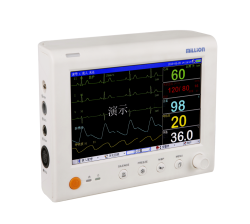Wechat QR code

TEL:400-654-1200

TEL:400-654-1200

A monitor is a system or device that can be used to control and measure a patient's physiological parameters and compare them to known settings and to alert you if there is an out-of-specification. It can continuously monitor blood pressure, electrocardiogram, temperature and other parameters of the patient, which can provide medical staff with a comprehensive and timely information on the patient's condition for medical treatment or emergency treatment. As society progresses and medical equipment continues to improve, the monitor will be popularized more quickly and become the most common medical device in wards. At present there are many types of monitors, including the more common portable bedside monitors and anesthesia monitors, etc. Next, we monitor the two as an example, the specific analysis, discuss their use, scope of use and so on the difference.
Conceptually distinguish portable bedside monitors and anesthesia monitors

The portable bedside monitor is a bedside patient-connected monitor that detects various physiological parameters such as blood pressure, ECG, body temperature, breathing and heart function. It can be specifically divided into single-parameter bedside monitors and multi-parameter bedside monitors. The single-parameter bedside monitor monitors and displays the patient in real time and continuously. If the patient's heart rate, ECG and other aspects of anomalies, it will automatically send an alarm, which is characterized by microcomputer data processing and diagnosis based on the established mathematical model; multi-parameter bedside monitor is basically the use of Plug-in structure, its configuration is relatively independent and very flexible, by changing the settings, either as a bedside monitor, but also as a center monitor. The anesthesia monitor is an instrument for inhaled general anesthesia. It uses semiconductor gas sensors and is chemically selected through a chemical dialysis membrane for quick and easy detection of different anesthetic gases. The utility model is characterized in that a semiconductor gas sensor is welded on a ceramic sheet by a semiconductor gas sensor, the ceramic sheet is tightly matched with a metal cylinder and is sealed and connected by a silicon rubber; the other end of the metal cylinder is separated by two chemical dialysis films A layer of glass sand core composition. It is an important tool that anesthesia must use to provide oxygen to patients, inhale anesthetics, and manage their breathing. It has four basic functions: First, it must be able to provide the power to deliver gas instead of a human respirator; secondly, he must meet the needs of respiratory metabolism to provide the appropriate amount of tidal volume or ventilation; Third, it The supply of gas to be heated and humidified, instead of the nasal function, but also to supply higher than the amount of oxygen in the air; Fourth, he should be able to produce a certain breathing rhythm, instead of the human respiratory central nervous system to control the function of respiratory rhythm. It is mainly composed of gas supply and delivery system, anesthetic gas volatile tank, breathing circuit system, ventilator, safety monitoring system and residual gas removal system, anesthesia information system and so on, its existence greatly improves the work efficiency of medical institutions.